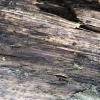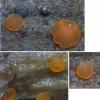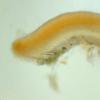
08-12-2025 21:04
Mark Stevens"Hello everyone,I'm relatively new to microscopy (

08-12-2025 18:59
 Lothar Krieglsteiner
Lothar Krieglsteiner
.. found by a seminar-participant, I do not know t

08-12-2025 17:37
 Lothar Krieglsteiner
Lothar Krieglsteiner
20.6.25, on branch of Abies infected and thickened

07-12-2025 16:07
Arnold BüschlenHallo, ich habe in einer Moos-Aufsammlung (epiphy

16-03-2014 22:00
Hello,I found this species a few months ago but ha

08-12-2025 13:39
Thomas Læssøehttps://svampe.databasen.org/observations/10572899

05-12-2025 17:33
 Bruno Coué
Bruno Coué
Bonjour, je serais heureux de recueillir votre avi
Possible Orbilia eucalypti
B Shelbourne,
07-03-2024 12:40
• Section Orbilia, series Orbilia: Dead ascus apex medium to strongly truncate in front view, ascus thin walled, spores more narrow and smaller SBs, vital spore length mostly < 6.5 µm, SBs globose, spore shape, without glassy processes.
• Series Orbilia, key A: Exudate over paraphyses sparse and finely granular, smaller SBs, capitate-clavate paraphyses, spore shape.
• Orbilia eucalypti (complex): Spore shape, spore width, without glassy processes, apothecia colour, spore size, with or without SBs, paraphyses with many small slightly refractive vacuoles, xeric.
• Variant with bright orange apothecia, larger spores, SBs?, and large basal cells.
Preparation and methods: Stored in a damp box attached to wood for several days, two central sections from a single apothecium examined, mounted in tap water, medium pressure applied to squash.
Habitat: On damp and decaying fence rail, decorticated, unidentified deciduous wood, white-rotted (under surface soft and and grainy), top rail ~1.5 m from the ground, presumably xeric, fence next to confluence of two streams, mixed deciduous woodland, southern England, late February, after wet weather and flooding.
Associates: Mollisia/Mollisiaceae sp., small and immature whitish-translucent apothecia not examined yet, chalara-like? dematiaceous anamorph (seems to be illustrated as an associate in the monograph), algae.
Apothecia: Several small groups, scattered to sub-gregarious, one cluster of 3-4, discoid, deep-bright orange, appearing superficial, sessile, appressed, sometimes partly lobate in maturity, slightly gelatinous appearance, soft texture; margin usually conspicuous, usually raised and +/- thick, smooth, more inconspicuous when fully mature with concave disc; disc slightly translucent, grainy appearance, slightly concave to plane, rarely slightly convex.
Asci: Narrow-cylindrical, rarely slightly clavate, often 2-4 (6) spores inversely oriented, inverse orientation more likely in lower spores, some spores rarely horizontally oriented, no discharged asci identified; base simple-septate, bifurcating, shapes Y, H, and h observed. Difficult to determine the vitality of asci without poisoning, many with more truncate apices were still relatively turgid and the content easy to resolve, general measurements ~50-70 × 3-5 µm.
• Mature and presumed vital (looks turgid): Width ~4-5 µm, apex hemispherical to obtuse, 1-1.5-seriate, spores obliquely arranged, pars sporifera ~50-70%
• Mature and presumed dead (contents more opaque or fully flaccid): Width ~3-4.5 µm, medium to strongly truncate in front view, rarely also centrally idented, still hemispherical in profile view, rarely small apical thickening ~0.5-1.3 µm, uniseriate, pars sporifera ~80-90%.
Spores: Broad range of shapes, cylindrical-clavate to smaller ellipsoid-ovoid, shape varies significantly in an apothecium and rarely within a single ascus, often heteropolar with the base more attenuated and acute, sometimes base tail-like and then sometimes curved in profile view (reniform); SBs globose, filum difficult to see, diam. ~0.5-0.7 µm, sometimes no SB or difficult to see amongst LBs?, several LBs around apex and occasionally some around base.
• Measurements of mature, vital spores ejected in water mount, released in squash mount, and inside (living?) asci:
(5.1) 5.6 - 7 (7.9) × (1.9) 2.2 - 2.7 (2.8) µm, Q = (1.9) 2.3 - 2.9 (3.2), N = 30, Me = 6.3 × 2.5 µm, Qe = 2.5.
Paraphyses: Apex slightly to strongly inflated, with shape narrowly-spatulate to clavate-capitate, apex ~1.5-4.5 µm wide, occasionally irregularly inflated (e.g. asymmetrical, mammiform-lanceolate, additional subapical inflation), apical cell longer ~1.5-2x, branching only observed at basal septa, not extending above mature asci, less apically inflated near margin?
VBs: Medium to large, yellowish, medium to slightly refractive VBs in paraphyses, and numerous, conspicuous, smallish, slightly refractive, yellowish-orange VBs in paraphyses, subhymenium, medullary excipulum, and marginal cells, in paraphyses especially found in lower cells and close to septa but often also in apices.
LBs: Frequent, with similar distribution to orange VBs.
Excudate: ~1 µm thick, pale orange-yellow, granular, forming patchy epithecium, coating margin and upper flanks, small granules from epithecium often remaining on apices of asci and paraphyses.
Subhymenium: Darkish orange.
Medullary exc: Pale orange, reduced, sometimes clearly separated from ectal by a layer of several horizontal hyphae.
Ectal exc: Textura prismatica-globosa, cells considerably larger in the centre, external cells more globose, hyaline, generally oriented perpendicular to the surface, marginal cells more elongated-cylindrical.
Subiculum: Appears to be some hyaline anchoring hyphae around the base.
Hans-Otto Baral,
07-03-2024 16:00

Re : Possible Orbilia eucalypti
Yes, clearly this species, the long-spored variant.
B Shelbourne,
07-03-2024 17:42
Re : Possible Orbilia eucalypti
Thank you for confirming.
The spores are certainly longer and more variable in shape compared to those in my first collection, which was found on hygric wood on the floor in November. There are other noticeable differences like the apothecia seem less translucent, longer asci to match the spores, and more apically inflated paraphyses.
The spores are certainly longer and more variable in shape compared to those in my first collection, which was found on hygric wood on the floor in November. There are other noticeable differences like the apothecia seem less translucent, longer asci to match the spores, and more apically inflated paraphyses.
Hans-Otto Baral,
07-03-2024 17:47

Re : Possible Orbilia eucalypti
When on the floor you must also consider O. tremulae.
B Shelbourne,
07-03-2024 20:07
Re : Possible Orbilia eucalypti
Yes, I remember that I couldn't decide which of these two species was a better match and you suggested O. eucalypti.







 Hymenium-0002.jpeg
Hymenium-0002.jpeg